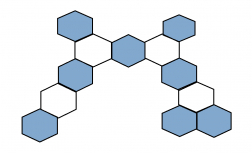About Yiqi Wang
In my opinion, sharing space and maximizing the use of natural factors to obtain lighting, achieve air circulation, indoor ventilation and water heating to reduce carbon emissions of the building.
Assuming a Hexagonal prism as a unit of the building, which can consist of one or two or three or thousands of units. The building could have different shape and different function via increase or decrease units. The shape of Hexagonal prism imitates honeycomb, which satisfies the lowest material to achieve the largest space.
Hexagonal prism
Shape 1
Shape 2
Shape 3
Sharing Space and changing function: If people or family members can take advantage of the public area, such as kitchen, activity room, and dining room, to reduce duplication of architectural space, which can achieve lower carbon emissions. Of course, taking into account the privacy of residence, the suitable layout and orientation of different areas are important. With the unit of the Hexagonal prism, the building can be changed all the time and it can be the private apartment, gallery, library, commercial office and every potential function, which save carbon emission within the limited space in some case.
The shape can get inrregular change and increase the extension to make the overlapping of the public space.
Lightening: Making the best orientation of the space to get advantage of the natural lightening, such as making the lightning well, increase the dimension of the window and setting the building in the northward.
Ventilation: Hexagonal prism can take the advantage of its variability which can make adjustment of ventilation with the change of the site and the season to make a natural ventilation.
Featured articles and news
RTPI leader to become new CIOB Chief Executive Officer
Dr Victoria Hills MRTPI, FICE to take over after Caroline Gumble’s departure.
Social and affordable housing, a long term plan for delivery
The “Delivering a Decade of Renewal for Social and Affordable Housing” strategy sets out future path.
A change to adoptive architecture
Effects of global weather warming on architectural detailing, material choice and human interaction.
The proposed publicly owned and backed subsidiary of Homes England, to facilitate new homes.
How big is the problem and what can we do to mitigate the effects?
Overheating guidance and tools for building designers
A number of cool guides to help with the heat.
The UK's Modern Industrial Strategy: A 10 year plan
Previous consultation criticism, current key elements and general support with some persisting reservations.
Building Safety Regulator reforms
New roles, new staff and a new fast track service pave the way for a single construction regulator.
Architectural Technologist CPDs and Communications
CIAT CPD… and how you can do it!
Cooling centres and cool spaces
Managing extreme heat in cities by directing the public to places for heat stress relief and water sources.
Winter gardens: A brief history and warm variations
Extending the season with glass in different forms and terms.
Restoring Great Yarmouth's Winter Gardens
Transforming one of the least sustainable constructions imaginable.
Construction Skills Mission Board launch sector drive
Newly formed government and industry collaboration set strategy for recruiting an additional 100,000 construction workers a year.
New Architects Code comes into effect in September 2025
ARB Architects Code of Conduct and Practice available with ongoing consultation regarding guidance.
Welsh Skills Body (Medr) launches ambitious plan
The new skills body brings together funding and regulation of tertiary education and research for the devolved nation.
Paul Gandy FCIOB announced as next CIOB President
Former Tilbury Douglas CEO takes helm.
UK Infrastructure: A 10 Year Strategy. In brief with reactions
With the National Infrastructure and Service Transformation Authority (NISTA).

























